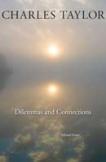A Social Imagination
Dilemmas and Connections is a collection of 16 essays by the Canadian philosopher Charles Taylor. Most have been or are about to be published in various places, and four appear for the first time. The topics treated range from the poetry of Paul Celan to the meaning of nationalism, from human rights to “Catholic modernity.” The issues are treated with the breadth of scholarship and insight that are typical of Taylor’s long career as one of the most significant contemporary philosophers.
To say that Taylor is a “significant philosopher” may require qualification. Gauged by the common concerns of mainstream English-language philosophy, Taylor may not seem to be a philosopher at all. English-language philosophy tends to concentrate on “the problem of knowledge,” with natural science as the prime example. What is scientific truth, and how does it affect claims for moral or religious “truth”? Philosophers who raise such questions favor fine-grained analysis of carefully delimited issues; few attempt the grand systems of an Aristotle or a Kant. Given the focus and style of this tradition, Taylor may seem to be more an intellectual and social historian; he has no grand system, but he does have a “grand narrative” for philosophy.
A prime example of Taylor’s rejection of the centrality of science is his scenario for the role of religion in the contemporary world. A common historical narrative sees medieval religion (superstition) destroyed once and for all by the rise of modern science. Taylor argues that the modern world starts not with scientific discovery, but with a moral revolution that can be traced as far back as the Lateran Council in 1215. The council sought to spread Christian practice widely to the laity by, among other admonitions, requiring yearly confession. Christian perfection was not just for spiritual elites like monks. Urging religious duties for all gradually changed the medieval “social imaginary.”
The medieval social imaginary projected an “enchanted world” in which existence participated in a great hierarchy of reality. In the enchanted world, places were not simply geographic expressions, but loci of sacred power: a sacred well, the Holy Land. Secular time participated in eternity: the calendar was organized around holy days. Individuals were not simply individuals but participants in higher realities: serfs to noble to king to priest to God. Eroding hierarchies of perfection—no distinction between laity and monk—began to undermine the enchanted world, creating modern “secularity,” in which life is viewed in the dimension of “horizontal” humanism, not in a “vertical” hierarchy of holiness.
Relating philosophy to the social imaginary distinguishes Taylor within the realm of English-speaking philosophy. Mainline concentration on the problems of knowledge subtly moves philosophy off the public street into the professorial study. Whatever is gained in precision, however, can be lost in public impact. (It is no accident that Taylor ran as a candidate for the Canadian parliament on three occasions.) For Taylor, philosophy ultimately emerges as commentary on the social imaginary. A notable expositor of Hegel, he might agree with the latter’s dictum: “The Owl of Minerva first takes flight at twilight.”
All the essays in this collection circle around the reality of the social imaginary. Anyone familiar with Taylor’s earlier magisterial work, A Secular Age, will be conversant with the outline of his position sketched above. Because this is a collection, there is significant overlap. Given the subtlety of Taylor’s narrative, I, for one, did not mind retracing the territory. In a book entitled Dilemmas and Connections, new “connections” were revealed.
What about “dilemmas”? One essay that I would particularly call to the reader’s attention is the previously unpublished “Perils of Moralism.” Moralism, says Taylor, stems from the temptation to codify morality. Given the fascination with science in English-speaking philosophy departments, there has arisen an urge to establish morals with something like theoretical certainty. (Or to abandon morals as mere emotion.) The result has been an incessant battle between two grand theories of morality: utilitarianism, in which consequences determine value, and Kantianism, which opts for categorical duties regardless of consequences. Both these theories seek a single, supreme principle from which one can decide the proper moral action.
Taylor says this is a fruitless quest. Codification fails because (1) “situations and events are unforseeably various”; (2) there exists a plurality of goods that can conflict in certain circumstances (there are genuine moral dilemmas.); (3) the resolution of a moral dilemma may be effected only by raising a higher-level concern: How will any moral decision affect the agents involved?
Taylor illustrates this “vertical” move by considering the situation in South Africa post-apartheid. The country was left with a serious issue—how to mete out justice to those who had perpetrated crimes of repression. On the horizontal level one could justify prosecution and punishment. The price of strict justice, however, would endanger “the future co-existence of ...exploiters and exploited in the new regime.” The solution of the dilemma was the Truth and Reconciliation Commission chaired by Bishop Desmond Tutu. Those who confessed would not be punished; “horizontal” justice would not be sought because of a vertical move to a higher community.
The transcending of horizontal justice is a continuing feature of the New Testament. Taylor cites the parable of the workers in the vineyard, in which those who labor through the heat of the day and those who come only at the end are rewarded equally. Clearly this is not just—except in the vertical dimension of God’s love. Taylor’s conclusion can be a profound challenge to certain influential views of Christian morality: “[There] aren’t any formulae for acting as Christians in the world. Take the best code possible in today’s circumstances.... [C]ould one, by transcending/amending/re-interpreting the code, move us all vertically? Christ is constantly doing that in the Gospel.” The medieval social imaginary was not all wrong: solving life’s dilemmas may lie in the vertical dimension.
This article also appeared in print, under the headline “A Social Imagination,” in the May 23, 2011, issue.








